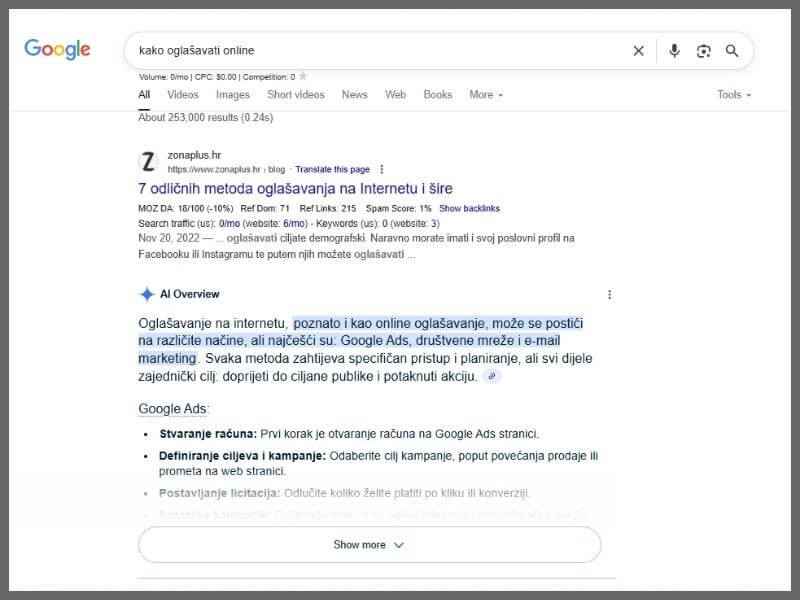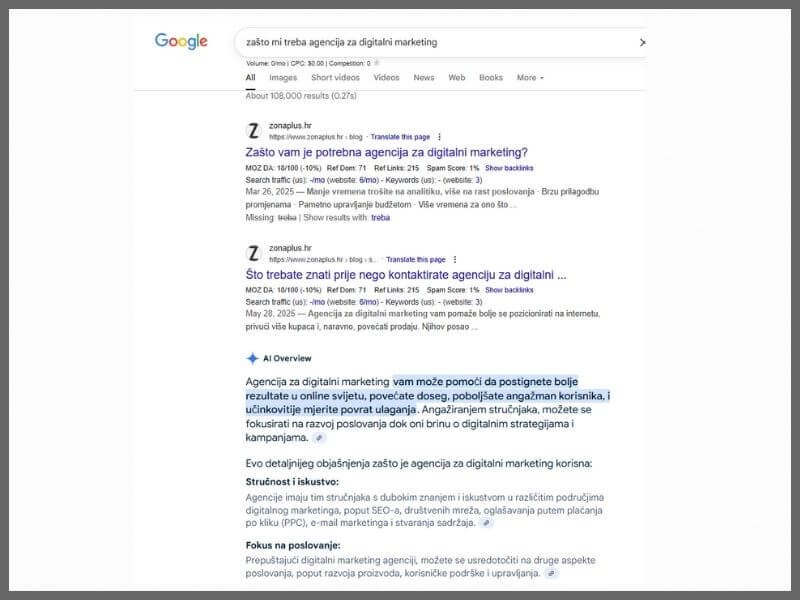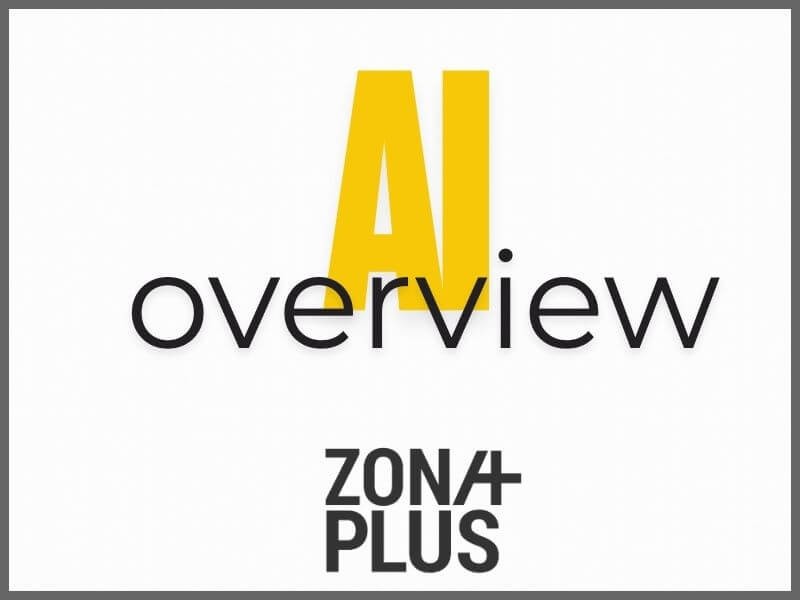
Imagine Google offering a ready-made answer to your question without you having to click a single link. That’s exactly what AI Overview brings – a new feature that uses artificial intelligence to compile a summary from multiple sources and display it at the top of the search results. The question is: are you ready to adapt your content?
You may have already noticed that some things on Google have changed.
More and more often, a ready-made answer appears at the top of the results for your query, without needing to click on any links.
That answer isn’t written by a person, but by Google AI Overview – a new feature that uses artificial intelligence to automatically generate a short summary from various sources.
Can this data be trusted or is Google “making up” content?
Google actually “reads” dozens or even hundreds of pages – its algorithm uses a technique called Retrieval‑Augmented Generation (RAG), meaning it retrieves relevant content from its index and generates a summary. That answer is displayed above the classic search results, in a dedicated box.

Unlike the usual list of links you have to go through yourself to find an answer, Google AI Overview provides a ready-made response.
This summary text, shown directly above the standard search results, is generated by artificial intelligence.
It is generated based on content from multiple sources that Google deems relevant and reliable.
For example, if you type “how to advertise online” into Google, you’ll get a short paragraph with specific tips (e.g. defining your target audience, choosing channels like Google Ads or social media, setting a budget). Above or below that paragraph, links to the pages from which the information was taken will be displayed.
This approach changes the traditional way of searching because:
It’s important to know that the AI Overview text is generated, not copied – the artificial intelligence writes it “on its own” based on content it finds online.
That’s why the content you publish needs to be precise, understandable, and well-structured so Google can more easily “extract” the parts that truly help people searching for that information.
For content creators, this means a new kind of visibility that’s not necessarily tied to ranking position.
Instead of the need (or pressure) to always be first on the list, it’s now more important to develop content that Google recognizes as trustworthy and useful, so that it includes it in the AI response.
Google AI Overview changes the way people access information, but also the way content is perceived and valued. Now that this feature is active, the answer appears directly at the top of the results, without the need to browse through multiple pages.
What this means for you and content creators:
If your text appears in the AI Overview, it means the algorithm considers it useful and accurate enough. In practice, content featured in AI Overview often sees:
Why is it important to appear in AI Overview?
If you work in SEO, content creation, or are simply someone who wants to be found on Google, here are a few reasons why it matters:
Visibility without being in first position
Your content can appear in the AI summary even if it ranks lower in the standard search results. This way, you reach people who might not otherwise click on your page.
An audience with clear intent
People asking specific questions and receiving your content as part of the answer are already motivated. They are looking for a solution, advice, or information, not just browsing casually.
Trust of the algorithm
AI Overview does not cite sources randomly. If your content repeatedly appears in those answers, it means you are recognized as a source that Google prioritizes.
AI Overview cannot guarantee a position, but it definitely opens up an additional opportunity to reach people who are looking for exactly what you are writing about. In industries where competition is strong, even that kind of visibility means a lot.

Google does not offer any official guidelines on how to appear in the AI Overview.
Still, we can already see what most often leads to certain content being highlighted and used as an answer:
Forget generic headlines and vague phrases. People search because they have a specific question, and your task is to answer it simply and precisely.
Use titles such as:
These kinds of titles appear on Google's radar precisely because they respond to what people are actually searching for. At the same time, it is important that the text doesn’t remain shallow but gives the reader a meaningful answer without needing to look further.
Google increasingly considers who is writing the content, with what kind of experience, and in what context. The E-E-A-T model is based on four criteria:
In practice, this means the following:
Pages that use structured data “communicate better” with Google’s algorithm.
By “communicate better,” we mean that the search engine more easily recognizes what exactly your page and text are about.
Structured data are essentially extra pieces of information added to your page’s code, which Google uses to better “understand” what you’re showing.
Examples of content often marked with structured data include:
If you use one of the more popular CMS platforms (e.g. WordPress, Joomla, Shopify), these systems already support structured data through plugins that help you implement them in just a few clicks.
The goal is simple. If Google can interpret your content quickly and accurately, there’s a greater chance it will display it in a prominent spot like AI Overview.
It’s not enough to simply change the publication date. Review which information is no longer accurate, what has become outdated, and what could be enhanced with more recent examples. For instance:
High-quality updates and improvements signal to Google that your website is active, maintained, and relevant.
AI responds much better to content that is clearly organized, text that makes sense and is logically arranged. Here’s what we mean:
If you can, add a table, infographic, or even a short video with captions. This is especially helpful when covering more complex topics or when you want the content to be more accessible.

Google’s search methods are changing. Just like the algorithms.
That’s nothing new.
No one can say with certainty what the results will look like in a year, let alone longer. What doesn’t change is the human need for clear, accurate, and well-explained information.
If you want your web content to be recognized, clearly written, and structured for the new type of Google search, contact us.
Google’s search methods are changing. That’s not news. No one can say with certainty what the results will look like in six months, let alone a year. But what doesn’t change is the user's need for clear, accurate, and well-explained information.
If you want your content to be ready not just for today’s Google but also for what’s coming next – contact us.